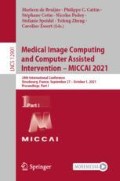Abstract
Diffusion-weighted (DW) magnetic resonance imaging is essential for the diagnosis and treatment of ischemic stroke. DW images (DWIs) are usually acquired in multi-slice settings where lesion areas in two consecutive 2D slices are highly discontinuous due to large slice thickness and sometimes even slice gaps. Therefore, although DWIs contain rich 3D information, they cannot be treated as regular 3D or 2D images. Instead, DWIs are somewhere in-between (or 2.5D) due to the volumetric nature but inter-slice discontinuities. Thus, it is not ideal to apply most existing segmentation methods as they are designed for either 2D or 3D images. To tackle this problem, we propose a new neural network architecture tailored for segmenting highly discontinuous 2.5D data such as DWIs. Our network, termed LambdaUNet, extends UNet by replacing convolutional layers with our proposed Lambda+ layers. In particular, Lambda+ layers transform both intra-slice and inter-slice context around a pixel into linear functions, called lambdas, which are then applied to the pixel to produce informative 2.5D features. LambdaUNet is simple yet effective in combining sparse inter-slice information from adjacent slices while also capturing dense contextual features within a single slice. Experiments on a unique clinical dataset demonstrate that LambdaUNet outperforms existing 3D/2D image segmentation methods including recent variants of UNet. Code for LambdaUNet is available. (URL: https://github.com/YanglanOu/LambdaUNet.)
Access this chapter
Tax calculation will be finalised at checkout
Purchases are for personal use only
Notes
- 1.
Note that our definition of 2.5D is different from that in computer vision, where 2.5D means the 2D retinal projections of 3D environments.
References
Bello, I.: LambdaNetworks: modeling long-range interactions without attention. In: Proceedings of the International Conference on Learning Representations (2021). https://openreview.net/forum?id=xTJEN-ggl1b
Charoensuk, W., Covavisaruch, N., Lerdlum, S., Likitjaroen, Y.: Acute stroke brain infarct segmentation in DWI images. Int. J. Pharma Med. Biological Sci. 4(2), 115–122 (2015)
Chen, J., et al.: TransUNet: transformers make strong encoders for medical image segmentation. arXiv preprint arXiv:2102.04306 (2021)
Chen, L., Bentley, P., Rueckert, D.: Fully automatic acute ischemic lesion segmentation in DWI using convolutional neural networks. NeuroImage: Clinical 15, 633–643 (2017)
Çiçek, Ö., Abdulkadir, A., Lienkamp, S.S., Brox, T., Ronneberger, O.: 3D U-Net: learning dense volumetric segmentation from sparse annotation. In: Ourselin, S., Joskowicz, L., Sabuncu, M.R., Unal, G., Wells, W. (eds.) MICCAI 2016. LNCS, vol. 9901, pp. 424–432. Springer, Cham (2016). https://doi.org/10.1007/978-3-319-46723-8_49
Falcon, W., et al: PyTorch Lightning. GitHub 3 (2019). https://github.com/PyTorchLightning/pytorch-lightning
Han, L., Chen, Y., Li, J., Zhong, B., Lei, Y., Sun, M.: Liver segmentation with 2.5D perpendicular UNets. Comput. Electr. Eng. 91, 107118 (2021)
Huang, G., Liu, Z., Van Der Maaten, L., Weinberger, K.Q.: Densely connected convolutional networks. In: Proceedings of the IEEE Conference on Computer Vision and Pattern Recognition, pp. 4700–4708 (2017)
Johnson, W., Onuma, O., Owolabi, M., Sachdev, S.: Stroke: a global response is needed. Bull. World Health Organ. 94(9), 634 (2016)
Kanchana, R., Menaka, R.: Ischemic stroke lesion detection, characterization and classification in CT images with optimal features selection. Biomed. Eng. Lett. 10, 333–344 (2020)
Lansberg, M.G.: Diffusion-weighted MRI in Acute Stroke. Utrecht University Dissertation (2002)
Mozaffarian, D., Benjamin, E.J., Go, A.S., Arnett, D.K., Blaha, M.J., Cushman, M., Das, S.R., De Ferranti, S., Després, J.P., Fullerton, H.J., et al.: Heart disease and stroke statistics–2016 update: a report from the American Heart Association. Circulation 133(4), e38–e360 (2016)
Oktay, O., et al.: Attention U-Net: Learning where to look for the pancreas. arXiv preprint arXiv:1804.03999 (2018)
Owolabi, M.O., et al.: The burden of stroke in Africa: a glance at the present and a glimpse into the future. Cardiovascular J. Africa 26(2 H3Africa Suppl), S27 (2015)
Paszke, A., et al.: Pytorch: An imperative style, high-performance deep learning library. arXiv preprint arXiv:1912.01703 (2019)
Ronneberger, O., Fischer, P., Brox, T.: U-Net: convolutional networks for biomedical image segmentation. In: Navab, N., Hornegger, J., Wells, W.M., Frangi, A.F. (eds.) MICCAI 2015. LNCS, vol. 9351, pp. 234–241. Springer, Cham (2015). https://doi.org/10.1007/978-3-319-24574-4_28
Zhang, C., Hua, Q., Chu, Y., Wang, P.: Liver tumor segmentation using 2.5D UV-Net with multi-scale convolution. Comput. Biology Med. 133, 104424 (2021)
Zhang, H., Valcarcel, A.M., Bakshi, R., Chu, R., Bagnato, F., Shinohara, R.T., Hett, K., Oguz, I.: Multiple sclerosis lesion segmentation with tiramisu and 2.5D stacked slices. In: Shen, D., Liu, T., Peters, T.M., Staib, L.H., Essert, C., Zhou, S., Yap, P.-T., Khan, A. (eds.) MICCAI 2019. LNCS, vol. 11766, pp. 338–346. Springer, Cham (2019). https://doi.org/10.1007/978-3-030-32248-9_38
Zhang, R., Zhao, L., Lou, W., Abrigo, J.M., Mok, V.C., Chu, W.C., Wang, D., Shi, L.: Automatic segmentation of acute ischemic stroke from DWI using 3-D fully convolutional DenseNets. IEEE Trans. Med. Imaging 37(9), 2149–2160 (2018)
Zhou, D., et al.: Eso-Net: a novel 2.5D segmentation network with the multi-structure response filter for the cancerous esophagus. IEEE Access 8, 155548–155562 (2020)
Author information
Authors and Affiliations
Corresponding author
Editor information
Editors and Affiliations
1 Electronic supplementary material
Below is the link to the electronic supplementary material.
Rights and permissions
Copyright information
© 2021 Springer Nature Switzerland AG
About this paper
Cite this paper
Ou, Y. et al. (2021). LambdaUNet: 2.5D Stroke Lesion Segmentation of Diffusion-Weighted MR Images. In: de Bruijne, M., et al. Medical Image Computing and Computer Assisted Intervention – MICCAI 2021. MICCAI 2021. Lecture Notes in Computer Science(), vol 12901. Springer, Cham. https://doi.org/10.1007/978-3-030-87193-2_69
Download citation
DOI: https://doi.org/10.1007/978-3-030-87193-2_69
Published:
Publisher Name: Springer, Cham
Print ISBN: 978-3-030-87192-5
Online ISBN: 978-3-030-87193-2
eBook Packages: Computer ScienceComputer Science (R0)


